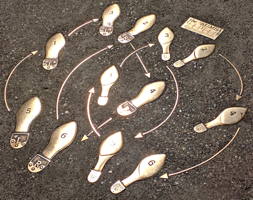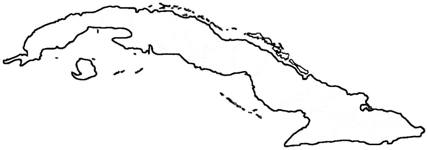
|
The Society of Folk Dance Historians (SFDH) Cuban Dance
[
Home |
About |
Encyclopedia | CLICK AN IMAGE TO ENLARGE |

|
In Cuba, dance and music are inseparable. To visitors, it seems as though every Cuban is born with an innate rhythm, impeccable footwork, and endless energy for smooth, sensual, and complex movements. Like Cubam music, the traditional dance forms are a combination of African and Spanish European influences with strong roots in African rituals. Cuban dance is a distinctive style known throughout Latin America and the wider world. Traditional Cuban music has its roots in African culture. Cuba is the birthplace of multiple dance forms, including Bolero, Cha-cha, Danzón, Danzonete, Mambo, Rumba, and Salsa.
DANZÓN
 Danzón is the official dance and musical genre of Cuba. In Cuba, these dances were influenced by African rhythmic and dance styles and so became a genuine fusion of European and African influences.
Danzón is the official dance and musical genre of Cuba. In Cuba, these dances were influenced by African rhythmic and dance styles and so became a genuine fusion of European and African influences.
The European influence on Cuba's later musical development is most influentially represented by Danzón, which is an elegant dance that became established in Cuba before being exported to popular acclaim throughout Latin America, especially Mexico. Its roots lay in European ballroom dances, such as the English Country Dance, French Contredanse, and Spanish Contradanza. Danzón developed in the 1870s in the region of Matanzas, where African culture remained strong.
The Danzón developed in 1879, and has been an important root for Cuban music up to today. Its precursor is the Habanera music, which is a Creolized Cuban dance form. The form of Danzón created by Miguel Faílde, begins with an introduction and paseo, that are repeated and followed by a sixteen-bar melody. The introduction and paseo again repeat before a second melody is played. The dancers do not dance during these sections; they choose partners, stroll onto the dance floor, and begin to dance at precisely the same moment: the fourth beat of bar four of the paseo, which has a distinctive percussion pattern that's hard to miss. When the introduction is repeated, the dancers stop, chat, flirt, greet their friends, and start again, right on time as the paseo finishes.
Early Danzón was played by groups called Orquestas Típicas, that were based on wind instruments. They had several brass instruments, such as cornet, valve trombone, and ophicleide (a keyed brass instrument similar to the tuba), a clarinet or two, a violin or two, and tympani (kettle drums). At the beginning of the 20th century, the lighter and somewhat more elegant sound of the Charanga emerged. Initially, they were small orchestra of two violins, a cello, flute, timbales (shallow single-headed drums with metal casing), güiro (an open-ended, hollow gourd with parallel notches cut in one side), and double bass (a large low-pitched bowed or plucked string instrument). Charangas and Típicas competed with each other for years, but after 1930 it was clear that the days of the Típicas were over.
CHA-CHA-CHA
Cha-cha-cha, or simply Cha-cha, is a dance of Cuban origin. It is danced to music of the same name introduced by Cuban composer and violinist Enrique Jorrín in 1953. This rhythm was developed from the Danzón by a syncopation of the fourth beat. The name is onomatopoeic, derived from the rhythm of the "güro" (scraper) and the shuffling of the dancers' feet.
Styles of Cha-cha-cha dance may differ in place of the "chasse" in the rhythmical structure. The original Cuban and the ballroom Cha-cha-cha count is "two, three, cha-cha-cha" or "four-and-one, two, three." The dance does not start on the first beat of a bar, though it can start with a transfer of weight to the lead's right foot. Nevertheless, many social dancers count "one, two, cha-cha-cha" and may find it difficult to make the adjustment to the "correct" timing of the dance.
BOLERO
Bolero originated in Santiago de Cuba in the last quarter of the 19th century; it does not owe its origin to the Spanish music and song of the same name. In the 19th century there grew up in the Santiago de Cuba a group of itinerant musicians who moved around earning their living by singing and playing the guitar.
Pepe Sánchez is known as the father of the trova musical style and creator of the Cuban Bolero. Untrained, but with remarkable natural talent, he composed numbersin his head and never wrote them down. As a result, most of these numbers are now lost, but two dozen or so survive because friends and disciples wrote them down. He was the model and teacher for the great trovadores who followed.
Bolero traveled to Mexico and the rest of Latin America after its conception, where it has become a part of their repertoires. Some of the Bolero's leading composers have come from nearby countries, most especially the prolific Puerto Rican composer Rafael Hernández; another example is Mexico's Agustín Lara.
MAMBO
Mambo is a dance style and musical form that developed originally in Cuba, with further significant developments by Cuban musicians in Mexico and the United States. The word "mambo" means "conversation with the gods" in Kiklongo, the language spoken by Central African slaves taken to Cuba. Modern Mambo began with a song called "Mambo," written in 1938 by brothers Orestes and Cachao López. The song was a Danzón. It was backed by rhythms derived from African folk music.
RUMBA
Rumba is primarily thought of abroad as a glitzy ballroom dance, but its origins are spontaneous, improvised and lively, coming from the dockworkers of Havana and Matanzas. Percussion instruments, including "quinto" (the smallest and highest pitched type of conga drum), the "tumbadora" (a tall, narrow, single-headed drum), and the "palitos" (sticks) to play a "cáscara" rhythm (a complimentary rhythm to the Son Clave, a foundation of Latin music), and vocal parts, including a leader and chorus, are combined to make a danceable and popular form of music.
The word "rumba" is believed to stem from the verb "rumbear," which means something like "to have a good time or party." The rhythm is the most important part of the Rumba, which is always music primarily meant for dancing.
There are three kinds of Rumba rhythms, with accompanying dances: Columbia, Guagancó, and Yambú. The Columbia, played in 6/8 meter, is danced by one man and is very swift, with aggressive and acrobatic moves. The Guagancó, played in 2/4 meter, is danced with one man and one woman, and is much slower. The dance simulates the man's pursuit of the woman, and is thus sexually charged. The Yambú, known as "the old people's Rumba," is a precursor to the Guagancó and is played more slowly. Yambú, has almost died out and is played almost exclusively by folkloric ensembles.
SALSA
Salsa dancing originated in New York in the mid 1970s. It evolved from earlier dance forms such as Son, Son Cubano, Son Montuno, Cha-cha-cha, and Mambo, which were popular in Cuba and other parts of Latin America at the time. Salsa, like most music genres, has gone through a lot of changes through the years and incorporated elements of Swing dancing and Hustle, as well as elements of Afro-Cuban and Afro-Caribbean dances such as Guaguancó and Pachanga. The latest form of Salsa being Timba, which is a form that has a stronger percussive content and at times incorporates Rap as a way to give the song a different feel and is only popular for the most part in Cuba.
In many styles of Salsa dancing, as a dancer changes weight by stepping, the upper body remains level and is nearly unaffected by the weight changes. Weight shifts cause the hips to move. Arm and shoulder movements also are incorporated. The Cuban Casino style of Salsa dancing involves significant movement above the waist, with up-and-down shoulder movements and shifting of the ribcage.
The arms are used by the "lead" dancer to communicate or signal the "follower," either in "open" or "closed" position. The open position requires the two dancers to hold one or both hands, especially for moves that involve turns, putting arms behind the back, or moving around each other, to name a few examples. In the closed position, the leader puts the right hand on the follower's back, while the follower puts the left hand on the leader's shoulder.
There is some controversy surrounding the origins of the word "salsa." Some claim that it was based on a cry shouted by musicians while they were playing their music. Others believe that the term was created by record labels to better market their music, who chose the word "salsa" because of its spicy and hot connotations. Still others believe the term came about because "salsa" dancing and music is a mixture of different styles, just as "salsa" or "sauce" in Latin American countries is a mixture of different ingredients.
BALLET
Cuba has ballet schools across the country. The Cuban National Ballet School (Escuela Nacional Cubana de Ballet) in Havana, with approximately three thousand students, is the largest ballet school in the world and the most prestigious ballet school in Cuba. The Cuban National Ballet is a renown ballet company located in Havana.
DOCUMENTS
- Caribbean, a region.
- Cha-cha, a dance.
- Cuba, a country.
- Latin America, a region.
Printed in Folk Dance Scene, June/July 2015.
This page © 2018 by Ron Houston.
Please do not copy any part of this page without including this copyright notice.
Please do not copy small portions out of context.
Please do not copy large portions without permission from Ron Houston.